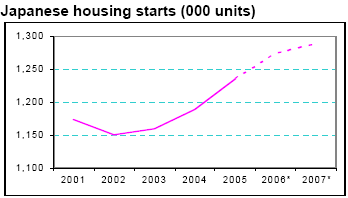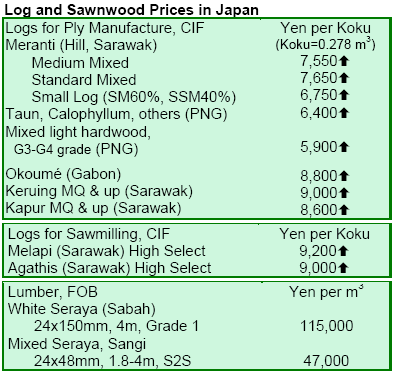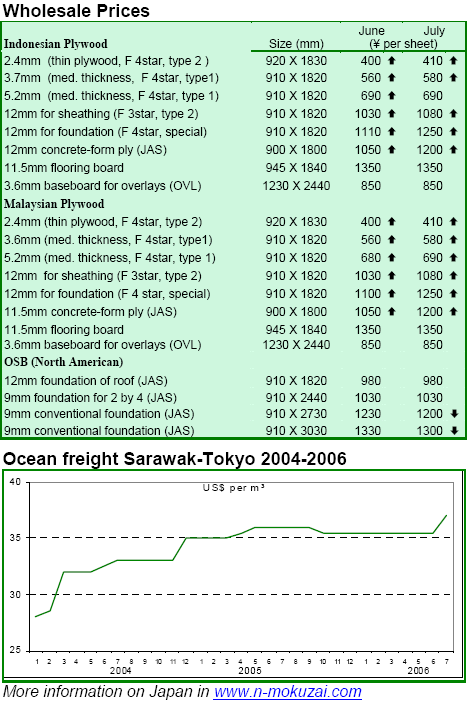|
Japan
Wood Products Prices
Dollar
Exchange Rates of 28th July 2006
Japan
Yen 114.76
Reports
From Japan
Rising rates lead to higher housing starts forecast
Daiichi Mutual Life Insurance’s Economic Research Institute (ERI) has forecast Japan’s housing starts at 1,275,000 units for 2006 (up 3.14% from 2005) and 1,290,000 units for 2007. However, the Research Institute of Construction and Economy predicted 1,241,000 units for 2006, slightly less than in 2005. Rental units and units built for sale will be the driving
factors of high housing starts, with rental units at 530,000 and units built for sale predicted to increase in both
years. ERI says rising interest rate would trigger rush in demand for housing. New housing starts have been higher than the previous year for four years since 2002.

The upbeat forecast is due to a picking economy, improving personal income and lower unemployment rate. However, the speed of increase in property value has been faster than wage increases over the last two years; this might dampen housing demand.
New plywood importing company established
A new plywood importing company, JKI, has begun operations with funding from Japan Kenzai Co., Ltd. JKI is constituted by former employees of the late Kanmatsu Co., Ltd., one of Japan’s largest plywood importers with sales of 1.5 to 2 billion yen of Indonesian plywood that
went bankrupt in February 2005. JKI operates in Kenzai’s head office and plans to initially source 10,000 m3 a month of plywood mainly from Indonesia and to double the volume in the mid term.
Japan-Malaysia FTA enters into force
The free trade agreement between Japan and Malaysia went into effect on 13 July, lifting all the duties of forest products from Malaysia except plywood. Sawnwood,freeboard, laminated lumber, LVL, blockboard, veneer,fiberboards, particleboard and FJL flooring are now all duty free. Plywood would be subject to continued negotiations between the two countries.
Plywood prices rise across the board
Prices of Southeast Asian plywood continue to rise. Supply of concrete forming, floor base, and structural panels is slightly lower than demand while demand for thin and medium thin panels is easing. Due to supply shortages of concrete forming panel, it is even feared that construction works might be suspended. Prices are expected to continue edging up in August. Southeast
Asian suppliers are accepting limited orders of 500-1,000 m3 per order. Malaysia’s Shin Yang Plywood Sdn Bhd has resumed taking orders but with limited volume and at higher prices. Japanese plywood manufacturers like Seihoku Plywood Co. have also raised prices to match fast rising prices for imported plywood.
Import volumes for plywood fall for second time
Japanese plywood imports dropped again in May, falling to 400,000 m3 (¥19.01 billion, CIF), down 4.3% in volume but up 3.6% in value (due to higher prices) from May 2005. Total imports in Jan-May 2006 reached 1.95 million m3, down 5.2% from last year. Just over 220,000 m3 came from Malaysia (up 13.6%), 113,000 m3 from Indonesia (down 35.5%) and 58,000 m3 from China (up
56% and the eleventh consecutive monthly increase).


|